African Music News: Ahmed Ould Kaddour - Moul El Âloua (2024)
"El Âloua" is one of the most famous and moving pieces of the âita repertoire, a staple at weddings and other parties, performed both by modern chaâbi groups and by traditional groups of chikhate. Like most âita songs, it is not associated with a single performer but rather belongs to the collective patrimony. However, the best version of the song, according to many, is that of singer and lotar player Ahmed Ould Kaddour.Ould Kaddour was born in 1934 in the town of Ben Ahmed. After performing lo"El Âloua" is one of the most famous and moving pieces of the âita repertoire, a staple at weddings and other parties, performed both by modern chaâbi groups and by traditional groups of chikhate. Like most âita songs, it is not associated with a single performer but rather belongs to the collective patrimony. However, the best version of the song, according to many, is that of singer and lotar player Ahmed Ould Kaddour.Ould Kaddour was born in 1934 in the town of Ben Ahmed. After performing lo

Ould Kaddour was born in 1934 in the town of Ben Ahmed. After performing locally for some years, he began in 1960 to divide his time between Ben Ahmed and Casablanca. Kaddour is sometimes called Moul El Âloua, i.e., owner or master of "El Âloua".
The term âloua in Moroccan Arabic means "small hill" or "hillock". The lyrics of the song "El Âloua" recount the itinerary of a pilgrimage to a specific hillock near Ben Ahmed where a group of saints' shrines are located. According to âita aficionados and performers, Ould Kaddour's version of "El Âloua" is considered the best because of his knowledge of the geography of the region and the location of the individual shrines [1]. Some say that he was the first performer to introduce this level of detail into the song [2]. Ethnomusicologist Alessandra Ciucci writes that the song is "celebrated for its ability to convey images and emotions stirred by the sacred voyage, and for allowing the audience to have the sense of participating in this experience as if it is occurring." [1] (For a deep dive into "El Âloua", its lyrics, the way it emerges in the course of performance, and the crucial role of women performers in shaping it, see Ciucci's excellent article, cited below.)
I am quite taken by Ould Kaddour's lotar playing. Whereas most lotar players use a plectrum, Kaddour strums the strings with his fingers, resulting in a more delicate sound, It reminds me, at times, of the sound of the Mauritanian tidnit.
Ahmed Ould Kaddour remains alive and well as far as I can tell. The most recent news I found was about him being honored at the 2017 National Festival of the Lotar. [3]
- A friend gave me this tape many years ago. It came with no j-card - only a a piece of paper with "No. African Folk" written on it.
- Being a human from the cassette era, I have only recently discovered that if I ask my phone to identify a song, Google will often be able to identify it when I stick my my phone near a speaker. This has transformed my last few months of non-playlisted radio listening (I'm looking at you KALX).
- I recently played this tape and, having no clue who the artist was, I half-jokingly asked Google "What is this song?". To my astonishment, the Google lady came back with "Mrida - Aandak Takhlae - Lahssab" by Ahmed Oueld Kadour.
- I searched for the track online and found this recording on YouTube. The song wasn't an exact match, but it was definitely the same artist! (I guess the lotar riffing was close enough for Google to consider it a match.)
- Armed with the artist's name, I hit the internet running, scouring for information. The aforementioned YouTube track was uploaded from the now-not-very-user-friendly-and-all-old-links-are-now-dead Yala.fm. However, Ournia seems to have all the tracks previously found at Yala. A number of Ould Kaddour tracks can be found at Settatbladi's page on the Internet Archive - where I found matches and titles for some of the music on my tape. (I wish I could find the title for Track 3 of the tape - the 6-minute unmetered introduction to the track is phenomenal.)
- The long Track 2 begins on side 1 and ends on side 2 of the tape. I was able to stitch them together into an uninterrupted single track.
- Finally, I grabbed the artwork from the only Kaddour tape I saw on Discogs. It's not the same album as mine, but I was able to work with the graphic, so there you go.
Hope you enjoy this tape. And hope you're all having a lovely summer!
Ahmed Oueld Kadour أحمد ولد قدورSakhi Disque cassette الساخ ديسك01 Moul Qoubba - Merchoum Sdar02 El Âloua - Hbiba03 Track 3320 | FLAC
References:
[1] Alessandra Ciucci (2017) "Performing ‘L-ʿalwa’: a sacred and erotic journey in Morocco", Ethnomusicology Forum, 26:2, 151-170. https://doi.org/10.1080/17411912.2017.1338595
[2] "Shikh Ahmed Ould Kaddour الشيخ أحمد ولد قدور". Episode of Sounaâ al fourja صناع الفرجة, Directed by Larbi Toto إخراج العربي توتو, Al Aoula 2010. https://www.youtube.com/watch?v=tNMrbKgbcRY
[3] "سطات: مهرجان لوتار في دورته السابعة يكرم الشيخ ولد قدور مبدع «العلوة» (Settat: 7th Edition of the National Lotar Festival Celebrates Shikh Ould Kaddour, Originator of El Âloua)". Article published at Casa 24, December 3, 2017. https://www.casa24.ma/culture/10429.html

 Musician
Musician 






![ZONDE nl Lyrics [Aaron Blommaert]](/img/?q=ZONDE nl Lyrics [Aaron Blommaert]&w=360&h=215)
![Redo för strid sv Lyrics [Korseld]](/img/?q=Redo för strid sv Lyrics [Korseld]&w=360&h=215)
![Svefneyjar is Lyrics [Sykur]](/img/?q=Svefneyjar is Lyrics [Sykur]&w=360&h=215)
![Gebre ca Lyrics [Foscor]](/img/?q=Gebre ca Lyrics [Foscor]&w=360&h=215)
![Ne vzame nihče sl Lyrics [Space Unicorn on Fire]](/img/?q=Ne vzame nihče sl Lyrics [Space Unicorn on Fire]&w=360&h=215)